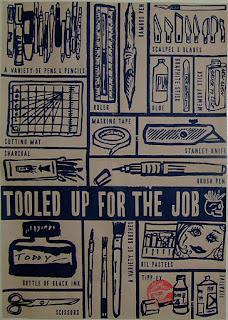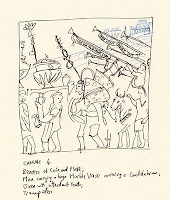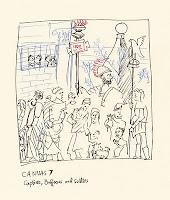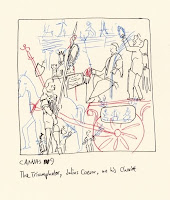
Now that the dissertation is in the past, I can bring out a few things that I found along the way.
I spent a few months trying to learn who was who in Italian Renaissance art, with the help of modern writers.
Here is a survey of fifeenth-century painting, as seen from the end of that century, in a section of a long rhyming poem (in
terza rima) by Giovanni Santi, chronicling the life of his employer, the Duke of Urbino. Santi, the father of Raphael, lived lived through much of the century, up to 1494, and looked with reverence to the artists that he named. Here it is, first in archaic Florentine and then in English, from one of my main texts, Baxandall's "Painting and Experience in Fifteenth-Century Italy".
The picture, fittingly for my current work, is Domenico Veneziano's "The Martyrdom of Saint Lucy".
ne la cui arte splendida e gentile,
nel secul nostro, tanti chiar son stati,
che ciescun altro far parer pòn vile.
A Brugia fu, fra gli altri più lodati,
el gran Jannès, e 'l discepul Rugiero,
cum tanti di excellentia chiar dotati,
ne la cui arte et alto magistero
di colorir, son stati sì excellenti,
che han superati molte volte el vero.
Ma in Italia, in questa età presente,
vi fu el degno Gentil da Fabrïano,
Giován da Fiesol, frate al bene ardente,
et, in medaglie e in pictura, el Pisano,
frate Philippo e Francesco Pesselli,
Domenico, chiamato el Venetiano,
Massaccio et Andreín, Paülo Ocelli,
Antonio e Pier, sì gran disegnatori,
Pietro dal Borgo, antico più di quelli,
dui giovin par d'etate e par d'amori,
Leonardo da Vinci e 'l Perusino
Pier dalla Pieve, ch'è un divin pictore,
el Ghirlandaia, el giovin Philippino,
Sandro di Botticello, e 'l Cortonese
Luca, de ingegno e spirto pelegrino.
Hor, lassando di Etruria el bel paese,
Antonel de Cicilia, huom tanto chiaro,
Giovan Bellin, che sue lode èn distese,
Genntil, suo fratre, e Cosmo cum lui al paro,
Hercule ancora, e molti che or trapasso,
non lassando Melozo, a me sì caro,
che in prospectiva ha steso tanto el paso.
In this splendid noble art
So many have been famous in our century,
They make any other age seem poor.
At Bruges most praised were
Great Jan van Eyck and his pupil Rogier van der Weyden
With many others gifted with great excellence.
In the art of painting and lofty mastery
Of colouring they were so excellent,
They many times surpassed reality itself.
In Italy, then, in this present age
There were the worthy Gentile da Fabriano,
Fra Giovanni Angelico of Fiesole, ardent for good,
And in medals and painting Pisanello;
Fra Filippo Lippi and Francesco Pesellino,
Domenico called Veneziano,
Masaccio, Andrea del Castagno, Paolo Uccello,
Antonio and Piero Pollauiuolo, great draughtsmen,
Piero della Francesca, older than these;
Two young men like in fame and years -
Leonardo da Vinci and Pietro Perugino
Of Pieve, a divine painter;
Ghirlandaio and young Filippino Lippi,
Sandro Botticelli, and from Cortona
Luca Signorelli of rare talent and spirit.
Then, going beyond the lovely land of Tuscany,
There is Antonello da Messina, a famous man;
Giovanni Bellini, whose praises spread far,
And Gentile his brother; Cosimo Tura and his rival
Ercole de' Roberti, and many others I omit -
Yet not Melozzo da Forlì; so dear to me
And in perspective so far advanced.




















































